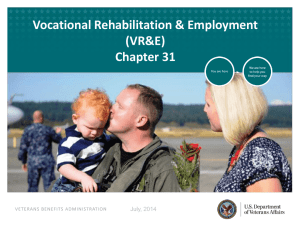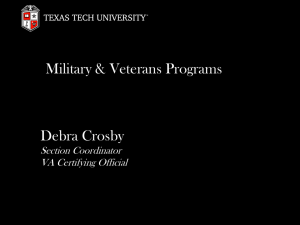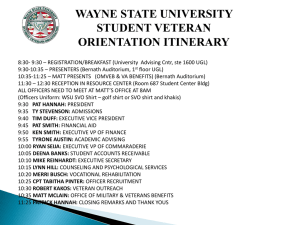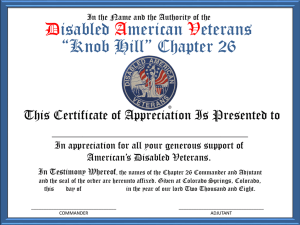Slides - We Honor Veterans
advertisement
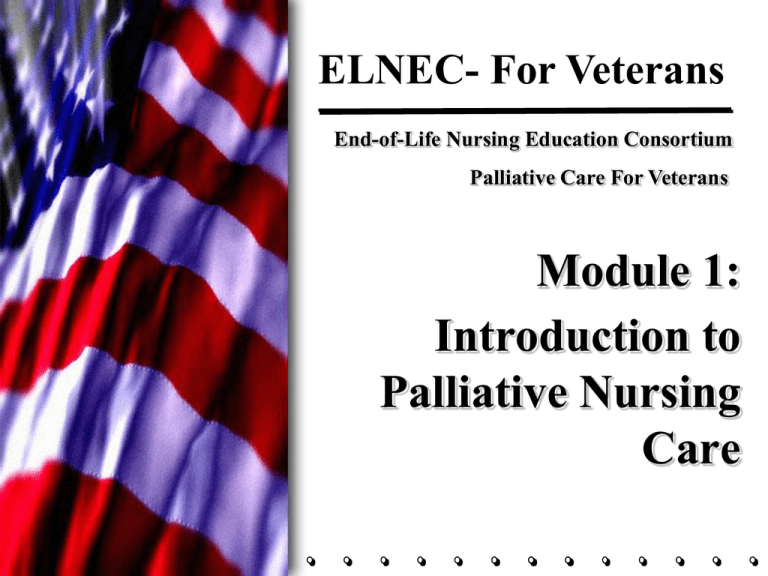
ELNEC- For Veterans End-of-Life Nursing Education Consortium Palliative Care For Veterans Module 1: Introduction to Palliative Nursing Care Veterans Affairs Motto “…to bind up the nation’s wounds, to care for him who shall have borne the battle and for his widow, and his orphan, to do all which may achieve and cherish a just and lasting peace among ourselves and with all nations.” President Abraham Lincoln 2nd Inaugural Address E L N E C For Veterans Curriculum Mission of the Department of Veterans Affairs Hospice and Palliative Care Program “To honor Veterans’ preferences for care at end of life.” Department of Veterans Affairs Office of Geriatrics and Extended Care http://www.va.gov E L N E C For Veterans Curriculum Demographics of Veterans •Projected –Over 5,000,000 Veterans cared for at a VA facility/year –US Veterans: 23,442,000 –Deaths of WW II Veterans/day: 900 –% of Veterans over the age of 65: 39.4% National Center for Veterans Analysis and Statistics, 2009; Casarett et al., 2008a E L N E C For Veterans Curriculum The Facts About Veteran Deaths • More than 50,000 Veterans die a month (600,000/year) –23,000 die in VA inpatient settings/year • Veteran deaths account for almost 28% of all deaths in the US • Approximately 85% do not receive care in a VA facility • Only 4% die in a VA facility NHPCO, 2010 E L N E C For Veterans Curriculum Veterans in the Community • Nearly 40% of enrolled Veterans live in rural communities • 121,000 Veterans are without shelter or healthcare, hence no access to hospice/palliative care NHPCO, 2010 E L N E C For Veterans Curriculum Nurses Caring for Veterans at the End of Life Must Understand the Culture • Enrolled Veterans –Social isolation –Lack of family support –Low income • Military camaraderie • Culture of stoicism US Department of VA Affairs, VA Health Administration, 2005 E L N E C For Veterans Curriculum Characteristics of VHA and Unique Characteristics of Enrolled Veterans •The largest integrated healthcare system in the US •Multi-layered benefits system •Large elderly population •Higher percent of homelessness than in general population •Multiple co-morbidities Back et al., 2005; Casarett et al., 2008a; Finlay et al., 2008 E L N E C For Veterans Curriculum Various Experiences Can Affect a Veterans Dying • What branch of service? • Enlisted? Drafted? Rank? • Age? • Combat and/or POW experience? • PTSD (assess for social isolation, alcohol abuse, anxieties)? • Stoicism Department of Veterans Affairs, VA Health Administration & Office of Geriatrics and Extended Care, 2005 E L N E C For Veterans Curriculum We Do Not Always Die the Way We Would Prefer •Care at home •Fear of pain •Financial burden •Invasive, painful treatments •Dependence on others •Role changes •Elderly caring for the sick Boni-Saenz et al., 2005; Egan-City & Labyak, 2010 E L N E C For Veterans Curriculum Hospice and Palliative Care • HOSPICE • PALLIATIVE CARE – Most intense form of palliative care – Less than 6 months to live – Agrees to enroll in hospice – Chooses not to receive aggressive care – Ideally begins at the time of diagnosis – Can be used to complement treatments NCP, 2009 E L N E C For Veterans Curriculum Hospice and Palliative Care cont. • BOTH – Interdisciplinary care – Provide pain and symptom management – Physical, emotional, social and spiritual care E L N E C For Veterans Curriculum Palliative Care NCP, 2009 E L N E C For Veterans Curriculum Death and Dying in America: Today • Over 4700 hospice programs in the US • Average length of stay in hospice is 69 days (median=21 days) • In 2007: 1,560,000 patients received hospice services and 41.6% of all deaths in the US were under the care of a hospice program • Patients with chronic illnesses make up the majority of hospice patients (i.e. heart disease, dementia, etc) NHPCO, 2005 & 2010a E L N E C For Veterans Curriculum Barriers to Quality Care at End of Life • Failure to acknowledge limits of medicine • Lack of training for healthcare providers • Hospice/palliative care services are misunderstood • Many rules and regulations • Denial of death Glare et al., 2003 E L N E C For Veterans Curriculum History of Palliative Care in VA • 1992: Policy— “All Veterans should be provided access to a hospice program…” • 1998-2000: VA Faculty Leaders Project for Improved Care at the End of Life • 2001: Training and Program Assessment for Palliative Care (TAPC) • 2001-2003: TAPC launched the VA Hospice & Palliative Care Initiative (VAHPC) – VAHPC Launched Hospice-Veteran Partnership (HVP) NHPCO, 2010b E L N E C For Veterans Curriculum History of Palliative Care in the VA (cont.) • 2003-Present: Palliative Care Consultative Team (PCCT) and Accelerated Administration & Clinical Training (AACT) • 2009- Comprehensive End of Life Care Initiative (CELC) – PROMISE E L N E C For Veterans Curriculum Palliative Care in the VA Today • VA provides palliative care consultation services at – ALL of its medical centers – Many Community Living Centers (CLC) – And contracts with community-based hospice programs to enhance VA’s ability to meet the end-of-life services of its Veterans • Over 60% of all Veterans who die in VA facilities receive care from a palliative care team Department of Veteran Affairs, VA Public Affairs, 2008 E L N E C For Veterans Curriculum Benefits of Palliative Care Consultation Teams (PCCT) in VA • Veteran’s goals of care are identified • Less likely to be admitted to ICU • Laboratory and technological tests decreased • Communication between PCCT and Veteran allow goals to be honored Penrod et al., 2006 E L N E C For Veterans Curriculum Differences in Cause of Chronic Illness and Death by Wars • • • • • E L N E C For Veterans Curriculum World War II Korean War Vietnam Gulf War Operation Enduring Freedom/Operation Iraqi Freedom Eligibility for VA Hospice Benefit • Included in the Medical Benefits Package (both inpatient or home settings) • Eligible for both VA and Medicare may elect to have hospice paid for under Medicare Hospice Benefit Department of Veterans Affairs, VA Health Administration & Office of Geriatrics and Extended Care, 2005 E L N E C For Veterans Curriculum Providing Hospice Services to a Veteran who Becomes an Inpatient • GENERALLY, VA provides needed inpatient hospice care at a VA facility (preferred option) • VA may utilize Community Nursing Home (CNH) contracts • VA may purchase inpatient hospice services from a community provider Department of Veterans Affairs, VA Health Administration & Office of Geriatrics and Extended Care, 2005 E L N E C For Veterans Curriculum Prognostication: May Be Used to Establish Goals of Care • Performance status –ECOG and Karnofsky are poor indicators • Multiple symptoms • Biological markers –Albumin, etc. • “Would I be surprised if this Veteran died within the next 6 months?” E L N E C For Veterans Curriculum Glare et al., 2010; Lamont & Christakis, 2007; Lynn et al., 2000 Two Palliative Care Frameworks for Assessing Patients • Making Promises Document: –Begin by envisioning what a better care system would look like • Quality of Life Model: –Identify physical, psychological, social, and spiritual aspects of care E L N E C For Veterans Curriculum Making PROMISES: Changing Systems of Care • Good Medical Treatment • Never Overwhelmed by Symptoms • Continuity, Coordination, & Comprehensiveness • Well Prepared, No Surprises • Customized Care, Reflecting Your Preferences • Consideration for Patient and Family Resources • Make the Best of Every Day Lynn et al., 2000 E L N E C For Veterans Curriculum QUALITY OF LIFE MODEL: Addressing Four Dimensions of Care Physical Psychological Functional Ability Strength/Fatigue Sleep & Rest Nausea Appetite Constipation Pain Anxiety Depression Enjoyment/Leisure Pain Distress Happiness Fear Cognition/Attention Quality of Life Social Spiritual Financial Burden Caregiver Burden Roles and Relationships Affection/Sexual Function Appearance Hope Suffering Meaning of Pain Religiosity Transcendence Adapted Adapted from from Ferrell Ferrell et et al., al., 1991 1991 E L N E C For Veterans Curriculum Role of the Nurse in Improving Palliative Care for All Patients • More time at the bedside than other healthcare providers • Some things cannot be “fixed” • Use of therapeutic presence • Maintain a realistic perspective • Keep Veteran’s goals first in all communication with the team E L N E C For Veterans Curriculum Maintaining Hope in the Midst of Death • Experiential processes • Spiritual processes • Relational processes • Rational thought processes Ersek & Cotter, 2010 E L N E C For Veterans Curriculum Extending Palliative Care for Veterans Across Various Settings • Nurses are the constant caregivers – In-patient settings – Clinics – Community living centers • Expand the concept of healing • Become well-educated • Willing to be a “change agent” E L N E C For Veterans Curriculum Final Thoughts • Quality palliative care addresses quality of life for ALL patients • Increased nursing knowledge is essential • “Being with” • Interdisciplinary care is vital E L N E C For Veterans Curriculum Consider……. What steps do you need to take to improve palliative care at your institution so that you and other members of the team are prepared to “care for him who shall have borne the battle…?” E L N E C For Veterans Curriculum




